Italy Unification Day !
Giuseppe Garibaldi is one of the two current Italian aircraft carriers, and the first “through-deck” aviation ship ever built for the Italian Navy, first to operate fixed-wing aircraft (Aquila was never completed and Miraglia only operated floatplanes). She is equipped with short take-off and vertical landing (STOVL) which limited the aircraft types she could carry, but also carried all sorts of helicopters usable for assault missions. Giuseppe Garibaldi saw combat air operations off Somalia, Kosovo, Afghanistan and Libya.
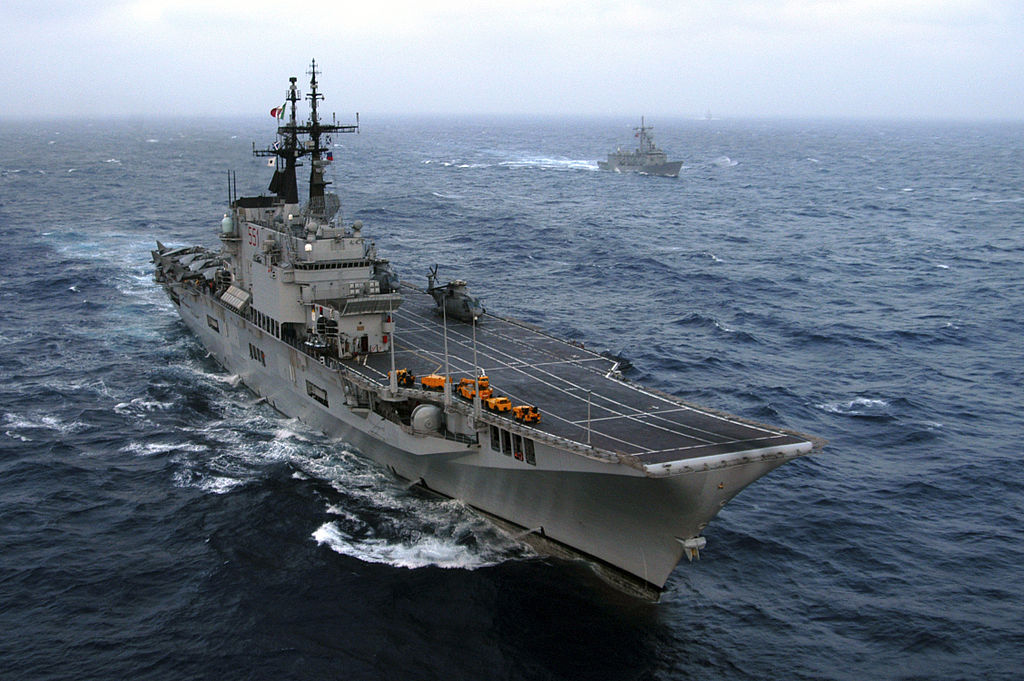
Genesis of the Design

Initial Fincantiery project in 1978 More
The program for such new ship originated into the need in 1970 already to plan the replacement of the two Doria class Helicopter cruisers (1962) of which Duilio was intended to act as training ship for Livorno Academy cadets, replacing San Giorgio.
Construction was planned in the Naval Law of 1975, and the previous yer, the Navy had submitted to the Italian industry a project prposal for the construction of an all-deck naval unit. The initial project included a flat flight deck typical of helicopter carrier. Italcantieri won the contest over a project from Breda. After another year of working out the design, the Marina Militare naval staff eventually ordered it on 21 November 1977. The contract with Italcantieri stipulated to start work on 20 February 1978.
The choice conformed in 1979 its through-deck appearance, instead of a hybrid cruiser as Veneto and the Dorias, enabling more spots for anti-submarine warfare.
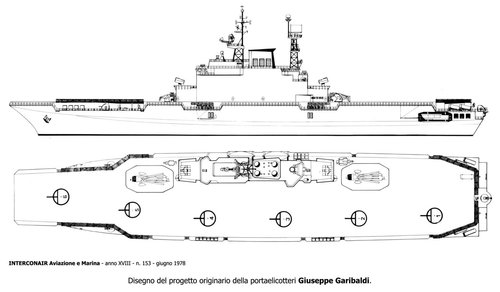
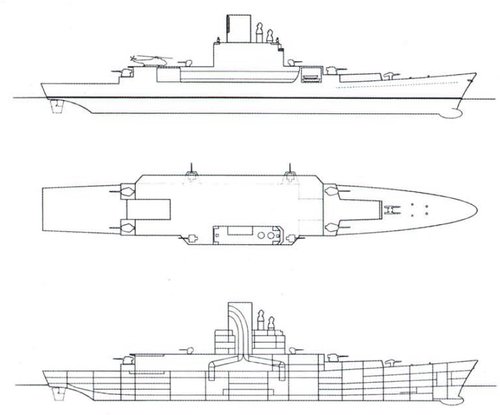
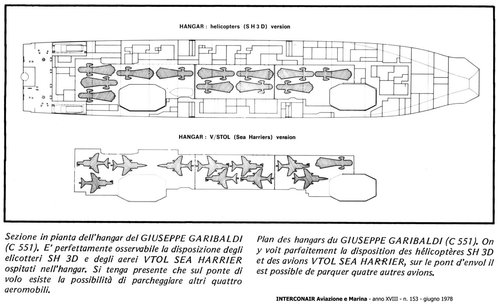
1978 Fincantieri project
It was believed a continuous deck would enable a larger group of anti-submarine helicopters indeed. Nothing was precised about STOVL aicraft at this stage, due to an ancient naval law (see later). In addition of these fonctions and those of a cruiser, she had to combine command and control capabilities, in order to lead a an offshore operational group and coordinate a task force, placing its resources at the fleet disposal and of external ships (for a NATO oriented closer cooperation).
Indeed, the first Italian aircraft carrier was originally limited in its capabilities by a law dating from 1923, preventing the Italian Navy from operating combat aircraft from ships. When this law was changed in 1992, sixteen AV-8B+ were purchased. The design envisaged VSTOL aircraft operations, since it ultimately included a ski-jump ramp forward.
Construction
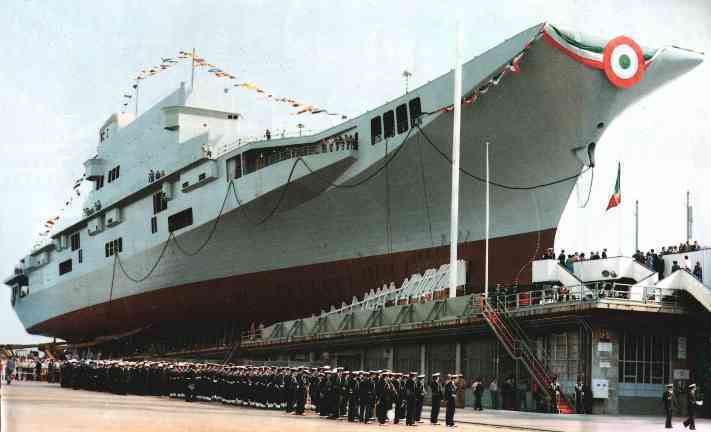
Launch in 1984
The construction of the unit took place in the Monfalcone factories. The cutting of the first sheet took place on 28 April 1980 and on 9 September of the same year construction of the first block began. On 26 March 1981 the first block was completed at Monfalcone shipyard. During construction of the deck it was decided to adopt a ski-jump not envisaged in the planning phase as planning the future adoption of aircraft.
On January 31, 1983, the assembly of the last block on the slipway was completed. By April 19, construction of the superstructure was complete. At last she was launched on 4 June 1983. The ceremony was attended by Prime Minister Amintore Fanfani, defense Minister Lelio Lagorio, who gave the inaugural speech. She was christened by Mrs. Flavia Donata Solvetti Garibaldi, wife of the last descendant of the namesake hero of the unification.

In drydock completion at Montfalcone
The ship started her initial sea trials on 3 December 1984 and she was eventually was delivered on 30 September 1985, the largest Italian warship so far in the Marina Militare, but she paled in comparison of Regia Marina designs, the Caraccoiolo and Litorrio class battleships or even the unfinished aicraft carrier Aquila (211 m long and 30,000 tonnes). She also was smallest aircraft carrier in the world at the time, considering she was completed as such. She would be dethroned by the Thai Chakri Naruebet in the 1990s.
Garibaldi received her symbolic battle flag in Naples, on October 3, 1987, delivered by the president of the National Sailors Association of Italy and by the presidency of the Italian Naval League. The flag was carried by the cruiser of the same name, WW2 Condotierri class veteran and entirely rebuilt as a missile cruiser.
Design of the class

Cutaway of the ship, from pinterest
Giuseppe Garibaldi was designed for anti-ship, anti-aircraft and anti-submarine warfare. But also perform command and control functions with a large combined force.
Thus, it had a sizeable crew and needed good accomodations to go with it. So between the core crew, needed for basic working of the ship (600), was added their air group crew, both pilots and ground personal (230), and above this, the command personnel close to 100+, and on top of it all in some conditions up to 600 troops.
The island is grouped around the single funnel, venting exhaust gases from the two propulsion units with diesel generators and auxiliary boilers (see later). This island was positioned on the starboard side, 60 meters long. It housed the command bridge, operating rooms. There two masts supporting most of the numerous electronic equipment, radars and sensors. Initially, a second continuous bridge was envisioned below the flight deck but stability rapidly imposed a more classic approach.
The design issue observed was that due to the limited width of the deck and placement of axial hangars instead of side ones, the elevators blocked communications between the two sides of the hangar during air operations, at least of aicraft recovery. Helicopter could be operated at all times from their spots, and VTOLs launched when still.
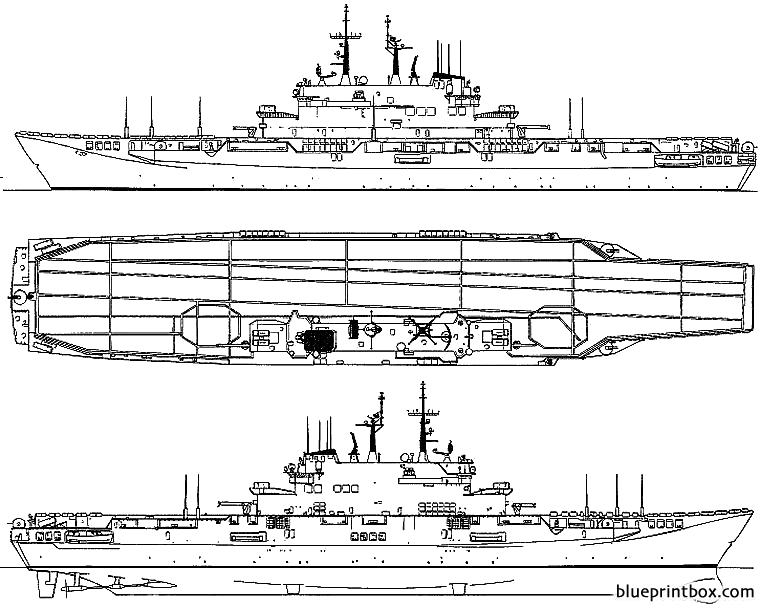
To operate at all times, Garibaldi is equipped with air conditioning. It also helps with the NBC protection for colective protection: All doors had seams and could be shut hermetically, and a constant flow of air and slight overpressure was unsured by 6 centrifugal electrocompressors, placed in pairs on three air conditioning stations. They were provided by Termomeccanica an together procured 3,000,000 Refigreration/h in summer, whereas the two heat exchangers procured 700,000 Cal/h in winter.
Hot and cold fresh water production units were distributed in 6 water tanks, four at the bow and two at the stern. They initially comprised two SCAM ScamFlash evaporators each capable of producing 120 tons daily. In 2002/2004 they were replaced by four ROCHEM-MARINE reverse osmosis desalination plants, also in pairs in the engine rooms. Hot water came from the mixed electric-steam boilers fed by 105°C steam fed by the four Bono auxiliary boilers 2 by 2 in the engine rooms, and electric heaters alternative or simultaneousl depending on onboard requests and crew size.
Hull and general design
The hull was divided into 13 watertight compartments by vertical bulkheads. Longitudinally she was given six decks and during the design phase, particular attention was paid to the hull’s external shape. A model was subjected to numerous tests at the INSEAN (National Institute for naval architecture studies and experiences) in Rome. At the request of Italcantieri, a basin was specially prepared for largeer model tests in rough sea conditions. It was also proceeded to a serie of cavitation tests on an aft shape hull section, as large as possible to be realistic. Maneuverability tests also took place on another 8.57 metre model on Lake Nemi (the famous lake on which Caligula’s floating palace once stood).
The hull as built was equipped with normal anti-roll fins and when speed exceeded 18 knots, two pairs of retractable fins went out so further stabilize her roll, powered by electro-hydraulic control. They allowed a roll reduction from 30° to just 3°, quite an achievement for a deck carrier, enabling air operation even in foul weather. There was also a system in place for a rebalancing of loads, wirh an internal sismic-type gyroscopic system that following movements by helicopters or planes. There was also transversal balancing system using two active compensation tanks located in the main area. The were filled and emptied using water expulsion using two electric pumps. The system was automatic also and contributed to counteract the roll and weight moving deck weights above. In the 1980s this was groundbreaking.
Powerplant
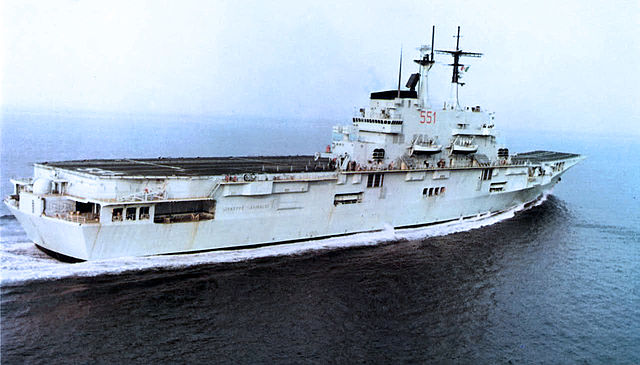
Garibaldi in sea trials, 1985
The propulsion scheme chosen was the new COGAG type arrangement: It comprised three sets of units working together. The powerplant area was divided into two groups separated by two other watertight compartments to survive flooding survival of at least one unit, and ship full controllability even with three adjacent compartments flooded. It comprised four General Electric/Avio LM2500 gas turbines, 60,400 kW (81,000 hp) in two twin unit rooms, and six diesel engine generators Grandi Motori Trieste B230/12, 9,360 kW (12,550 hp), coupled with electric generator Ansaldo-Elettrital, 1,560 kW (2,090 hp) each. This procured 30 knots and Range at 20 knots was approximatively 7,000 miles (13,000 km) depending on the sea conditions and use.
-Four LM 2500 gas turbines (From Avio under license from General Electric) which were rated for 25,000 HP and usually capped to 20,000 HP in order to prolongate their operational life,for a total in operation of 82,000 hp (60 MW) (4x 20,500), driving the two shafts, ending with fixed five-blade propellers.
The left transmission comprised two gas turbines placed closest to the bow, direct line, with the left propeller turning in the same direction as the turbines. The left transmission line placed starboard comprised two gas turbines closeer to the stern and reversed (the prop rotates inverse to the turbines, with a rotating arrangement of 180° of the engine for the coupling.
-Two Vulcan/Tosi reducers/reversers. There was a tranmission allowed in forward gear to turn thes inwards at a top speed of 30 knots and managed reverse of slow rotation at the lowest output available in case some systems fails. The transmission allowed using a single shaft line, driven by one or two gas turbines if needed.
-Six B230/12 diesel engine generators: They were manufactured by Grandi Motori Trieste and rated total for 9,360 kW (12,550 hp). They are coupled with electric generator Ansaldo-Elettrital developing 1,560 kW (2,090 hp) each (see later).
-A main funnel: Air was drawn to feed the turbines and boilers from stainless steel ducts independent of each machinery space and present on both sides between the 1st corridor and the flight deck. They had a smoke reducer, altair dehumidifier filters, silencers, anti-icing. Smoke and associated residues are exhausted in the island’s funnel through pipes, with gas temperature reducer and outer cooling filters to reduce her infrared signature.
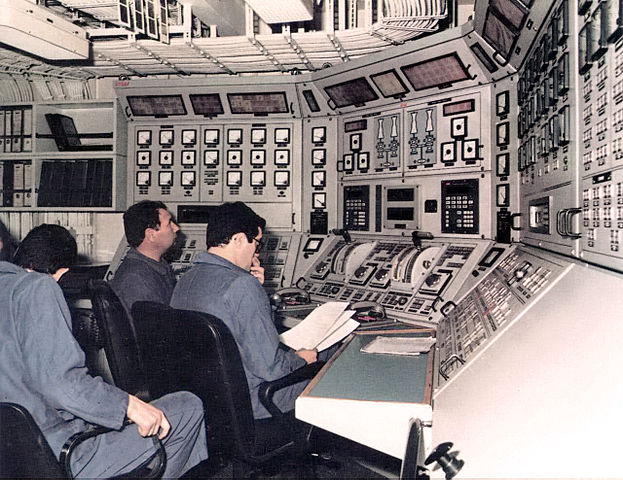
The SEPA Console
The whole powerplant is controlled from a centralized S.E.P.A. 7614 with all command and control consoles. This POC (Platform Operations Centre) relays orders from the bridge and monitors all critical systems of the power units as well as C.A.M. auxiliary for the degraded pipeline of the gas turbines located in the bow and stern.
Onboard Electric Power
Electricity needed to power all aboard systems, from the radar to the bridge, also comprises a part in the main propulsion system: The six generators (two usable in emergency) are comprose of fast diesel engines from Grandi Motori, supercharged, charging in turn three-phase synchronous alternators (from Ansaldo-Elettrital) rated for 440 V-1560 kW. They could function independently or with the four power plants and managed from the SEPA console and SACIE integrated system.
Two of these power units are located in the forward engine rooms and two in the stern rooms. The diesels are enclosed separately, in soundproofed anti-acoustic modules and had their own internal fire-fighting systems. The two emergency groups are placed in outside rooms forward and aft ensuring even with full flooding some remaining power for essential systems (like pumps). For this, they are placed on the safety bridge, with discharges port of the flight deck. The are used to power deck operation systems like aircraft engine starters.
Armament
Designed a bit as a cruiser, the Garibaldi was given a substantial self-defence capabily in case her escort would be compromise or when operating alone. Proportionally she is better armed than standard USN aicraft carrier for example, which relied more on their task force and own air group.
2×8 Selenia SAM
For medium-range air defence, the ship is equipped with two eight-cell Selenia “Albatros” hand-held missile launchers, located on the forward and aft deckhouses of the island and equipped with an exhaust gas dispersion barrier to protect the flight deck, each of which it has eight missiles ready to launch and sixteen in reserve for a total of forty-eight Aspide missiles.
8×1 OTOMAT SSM
Originally an anti-ship guided missile system based on four OTOMAT missile launchers was also installed, positioned laterally at the extreme stern, with the possibility of using a total of eight containers superimposed in pairs for the Mk-2 version with folding wings, landed in 2003 to allow an enlargement of the flight deck.
Breda OTOMAT 40mm/70
For the close anti-aircraft defense there are three twin turrets equipped with Breda 40mm/70 light cannons integrated into the Dardo point defense system; the three turrets, with a rate of fire of 300 rounds/minute (and a range of 4km against missiles and aerial targets and 12km against surface targets) are positioned so as to guarantee a 360° optical view, with two turrets positioned on the lateral sides and one at the extreme stern.
ASW Protection
For anti-submarine defence, the ship has two triple torpedo launchers of the 324mm ILAS-3 type, similar to the American MK 32 type, armed with Mk 46 and A-244 light torpedoes[14]. The same light torpedoes also equip the onboard ASW helicopters.
Sensors
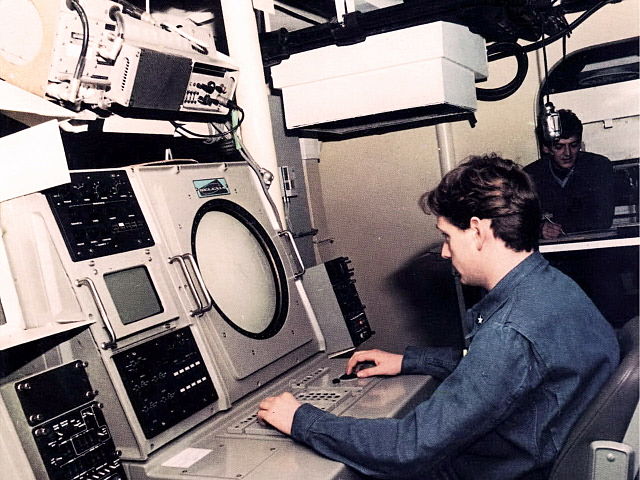
The console of the Selenia IPN 20 system
The vital center aboard was the COC (Combat Operations Center) scaning and managing all ship activities both in exercises or real crisis. It was located behind the Command Bridge and hosted the Selenia IPN 20 system collecting data from all sensors and communication arrays as part of SADOC-3 (System Automated for the Directorate of Combat Operations) receiving and processing and providing redigested information in real time, for better situation awareness, and from analogical to digital means. It was tasked of activating defensive systems according to threat level encountered and guiding combined responses.
The room comprised ten single operator vertical consoles displaying the integrated data processing system Selenia IPN-20 tracking and following a single selected activity for each, while the center two multiple consoles followed all the activities diplaying the overall tactical situation. There was also a large horizontal display console to have the most important data on sight at all time.
The Automated System for the Management of Combat Operations was pioneered on the Audace class destroyers, as part of SADOC 1 but with command-only capability, and had been expanded to Command and Control (C2), Communications (C3) and C4I (+Computer and Information tasks) with transmission by the Elmer communications system (Link 11 HF and UHF Link 14) and Link 16 from 2003.
Main Warning & Detection Radars
Hughes AN/SPS-52C: A long range air search 3D E-band radar with 400 km range working with the following:
Selenia MM/SPS-768 (RAN-3L): 3D long-range air detection radar, D band, 200 km range, fitted with IFF Mk. XII.
Selenia SPS-774 (RAN-10S): 2D radar with 150 km range, for medium range/low altitude air search fitted with IFF Mk. XIII.
FCS Radars
S.M.A. MM/SPS-702: Surface search only, 2D, band I radar installed on a bracket of the bow mast also tasked to spot low-flying air targets (like sea-skimming missiles) fitted with the MM/UPC-718 with IFF transponder MM/UPC-719 and G/H band antenna for remote control of the Teseo missiles.
Radar MM/SPS-702 CORA New antenna installed in the 1990s enclosed in a smaller radome, one the starboard vertex.
Three SPG-75 Albatross/Aspide system firing directions coupled with Selenia RTN-30X Orion radar and Elsag NA-30B Argo control unit (top of the helm station and aft of the funnel). Three SPG-74: FCS of the three Dardo CIWS, coupled with with Selenia RTN-20X radar and Elsag NA-20 control unit, close to the mounts.
Sonar
Low-frequency sonar Raytheon DE 1160LF mounted on the hull. Replaced by an Italian DMSS-2000 unit after the overhaul of 2003.
Navigation
GEM Elettronica MM/SPN-749 navigation radar: operates in band I with a peak power of 20 kW, with two separate antennas, master and slave on the bridge.
SMA MM/SPS-703 navigation radar: Planned to be placed on a shelf positioned on the bow mast below the MM/SPS-702 radar, planned but not installed.
MM/SPN-749 system: GEM Elettronica using two antennas positioned in the forward/aft areas of the island.
Tacan URN-25: Usef for aviation take-off and landing, and with radio IFR flight procedures.
Electronic Warfare
For electronic warfare operations, the unit is equipped with the integrated ESM/ECM Elettronica MM/SLQ-32 Nettuno system, whose elements operate both in ECM (Electronic Counter Measures) function active for disturb and deceive enemy radars and enemy missile guidance systems, both in passive ESM (Electronic Support Measures) function, for the localization and analysis of emissions from electronic equipment deemed not friendly.
AN/SLQ-25 Nixie system: Electronic anti-torpedo protection system, NATO stan,dard. It is given a source of anti-torpedo decoys emitting fake propeller/engine noises deceive and deflecting incoming torpedoes. Replaced by the AN/SLQ-25B with better sensors locating incoming torpedoes.
Breda SCLAR launchers: Located on the aft part of the island are two twenty launcher 105mm flares/chaff for missile jamming. After 2003 they were repositioned.
Air Facilities

She had a through deck with an island with a total superficy of 5,000m² (), and below a 1,650m² () hangar for a total parking space of 9,900m³ (). The Flight deck measured 173.8 meters long by 30.4 meters wide (). The Hangar measured 110 meters long by 15 wide and 6 meters tall, served by two elevators of a semi-rounded shape, each measuring 18 m long for 10 m wide () and 15 tonnes ( Ibs.). There was no catapult but a 6.5°-inclined, 28.5 meters long () ski-jump.
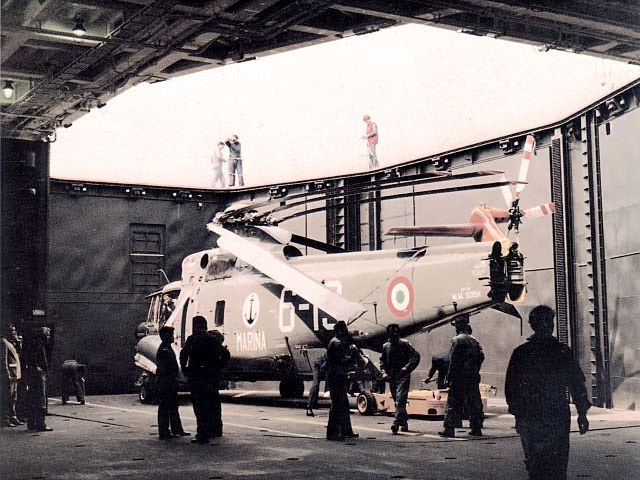
The Deck configuration of the aircraft carrier Giuseppe Garibaldi comprised an offset setting from the longitudinal axis. The in-construction addition of a ski-jump inclined at 6° had a total superficy of 174 meters for 30 meters, with the excluzion area formed by the large island. The deck was surrounded by a side walkway for safe personnel movement, the arrangement of ancillary equipment: Refueling points, power sockets, fire-fighting services. This walkway was placed one meter below the flight deck. To compensate for the slight increase in height with the bow, further improvement of the ship stability in rough sea conditions was done (as seen above for the hull design).

The hangar below the flight deck was divided into three sections for fire fighting with rapid-closing fire proof curtains, and two rigid fire walls. Sprinklers and smoke detection systems were also installed under the roof. The decks elevators could carry 18 tons, and hed been provided by Navalimpianti. They were placed respectively forward and aft of the island superstructure and practically aligned with it.
There were deck sprinklers, enabling to clean the deck from combustion residues, but also to rapidly extinguish any fires. Markings comprised a straight track in white (the deck was dark grey), running straight from aft to bow, parallel to the island, and divided into six areas and four internal guiding lines for the jets. However there was a further marking, double lines colored in black off-set for VTOL landings. It was not usable when the six spots were used though. The latter was also placed to the port side, three parallel and two more inwards the deck, the last being placed at the end of the forward deck section.
Air Group
The first fixed-wing aircrafts of the Italian Navy
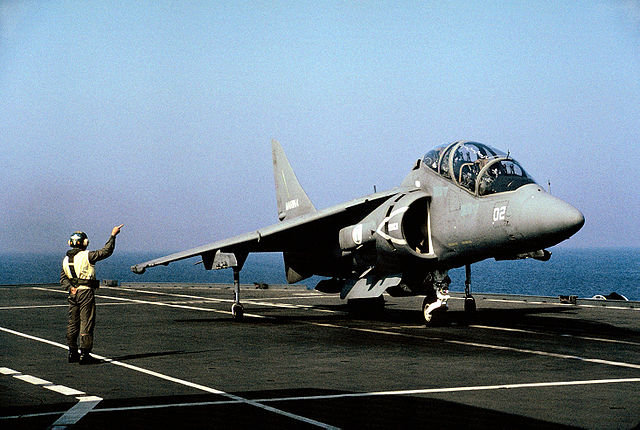
Due to the legislation from 1923 banning fixed-wing military aircraft from the Navy, the Giuseppe Garibaldi had to wait for the law being changed in 1989. It was expected sooner, and during construction a ski-jump was added. The Law 36 of 1 February 1989 authorized this and given the size of the ship, any CATOBAR configuration with catapults was out of questions. The choice fell early on to British Sea Harrier and its more modern equivalent AV-8 Harrier II.
The latter was chosen due to its most sophisticated multi-mode radar, equal to the one carried by the F/A 18 Hornet. In 1990 the order of two AV-8B+ was confirmed and soon pilots and technicians were sent for training in the US. On June 7, 1991 official delivery took place at the Marine base of Cherry Point in North Carolina. They were received aboard Garibaldi on August 23 aboard the Garibaldi as she was moored off Norfolk, Virginia.
Garibaldi only embarked them operationally at the end of 1991 for international exercises with flight deck operations going on through NATO Dragon Hammer 90.. Italy was part of the coalition deployed against Iraq in the first gulf war and these came right on point. The park comprised both Sea Harrier in the single and dual seat versions (the latter being called TAV-8B). It is assumed they carried ten single-seat and two dual seat versions.
(to come)
HD Author’s illustration of an Italian AV8B Harrier
Helicopter Group

(to come)
HD Author’s illustration of a Sea King SH3D of Garibaldi

HD Author’s old illustration of a Sea King SH3D

Old Author’s illustration of the AB-212

Old Author’s illustration of an Italian AW-101
Her final air component was to be alternatively composed of up to a maximum of 12 STOVL AV aircraft of the 8B Harrier II and 6 helicopters for a total of 18 aircraft total, 12 parked in her Hangar and 6 on the flight deck, although she had a total capacity of 36 when taxing them. She also could only take aboard 18 Agusta SH-3D helicopters.
However it varied in time:
In 1990 she carried typically 16 SH-3D Sea King. In 1991 she received her first two AV8s and more followed in 1992-93. In 2005 she had a permanent park of six AV-8B Harrier and four SH-3D Sea King. In 2012 this went up to ten AV-8B Harrier (she only had a nominal capacity of 12) and a single SH-3D Sea King and the latter in 2017 was replaced by an AW101 AEW Merlin. But in 2017 she retained an all-helicopter park of eighteen AW101 Merlin, AW101 AEW Merlin and NH90 NFH models.
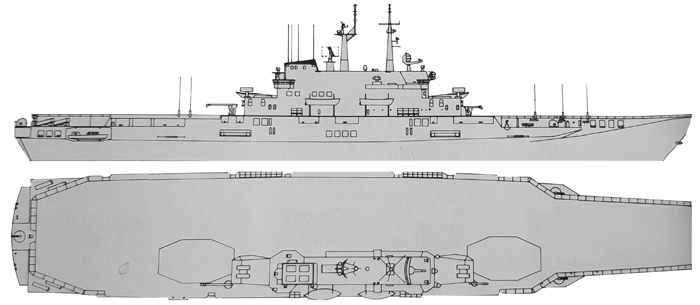
Conway’s profile
⚙ specifications |
|
| Displacement | 10,100 t standard, 13,850 t FL and 14,150 t after 2003 MLU |
| Dimensions | 180.2 x 33.4 x 8.2 m (591 x 110 x 27 ft) |
| Propulsion | 4× GE/Avio LM2500 GTs 60,400 kW (81,000 hp), 6× diesel Gen. 9,360 kW (12,550 hp), electric Gen. 1,560 kW (2,090 hp) |
| Speed | 30 kn (56 km/h; 35 mph)+ |
| Range | 7,000 nmi (13,000 km; 8,100 mi) at 20 kn (37 km/h; 23 mph) |
| Armament | 2×8 Mk.29 Sea Sparrow/ Aspide SAM, 3×2 40L70 DARDO 2× 324 mm TTs, 4× Otomat Mk 2 SSMs |
| Air Group | 12 AV-8B Harrier II/ASH-3D/AW101 helicopters |
| Sensors | MM/SPS-768, SPS-774, AN/SPS-52C, SPS-702, SPN-749 nav, SPN-728, 3x RTN-30X & RTN-20X FCR, DE 1160 LF sonar, CMS SADOC-3 TACAN URN-25, SLQ-732, 2x SCLAR, AN/SLQ-25 Nixie |
| Crew | 830: 550 Crew, 180 Fleet Air Arm, 100 C4 staff |
Reception and Modifications
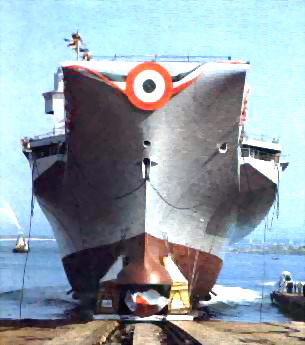 The hangar was designed to accommodate either twelve SH-3D Sea King helicopters or ten AV-8B and one Sea King. Garibaldi was ordered on 20 February 1978, starting sea trials on 3 December 1984 and in about c1990 the original four Otomat SSMs was replaced by eight Otomat 2 SSMS (folding wing type). Only four missiles are usually carried, however. She is equipped as a fleet flagship and also serves as an ‘interpreter’ between the on-shore Italian air defence system and deployed ships (their electronic data links are not compatible with the land-based system). Like the British Invincible class she can carry troops (up to 600).
The hangar was designed to accommodate either twelve SH-3D Sea King helicopters or ten AV-8B and one Sea King. Garibaldi was ordered on 20 February 1978, starting sea trials on 3 December 1984 and in about c1990 the original four Otomat SSMs was replaced by eight Otomat 2 SSMS (folding wing type). Only four missiles are usually carried, however. She is equipped as a fleet flagship and also serves as an ‘interpreter’ between the on-shore Italian air defence system and deployed ships (their electronic data links are not compatible with the land-based system). Like the British Invincible class she can carry troops (up to 600).
So in the late 1980s her four single Otomat Mk 1 SSM were replaced by four twin Teseo Mk 2 SSM (8 Otomat Mk 2) and in 2004, the latter were removed as well as the SPN-728(v)1, SPN-749(v)2 radars and DE1160 sonar: Her electronics suite was completely modernized with the installation of a SPS-753 radar, DMS 2000 sonar and SLAT anti-torpedo system.
Succession
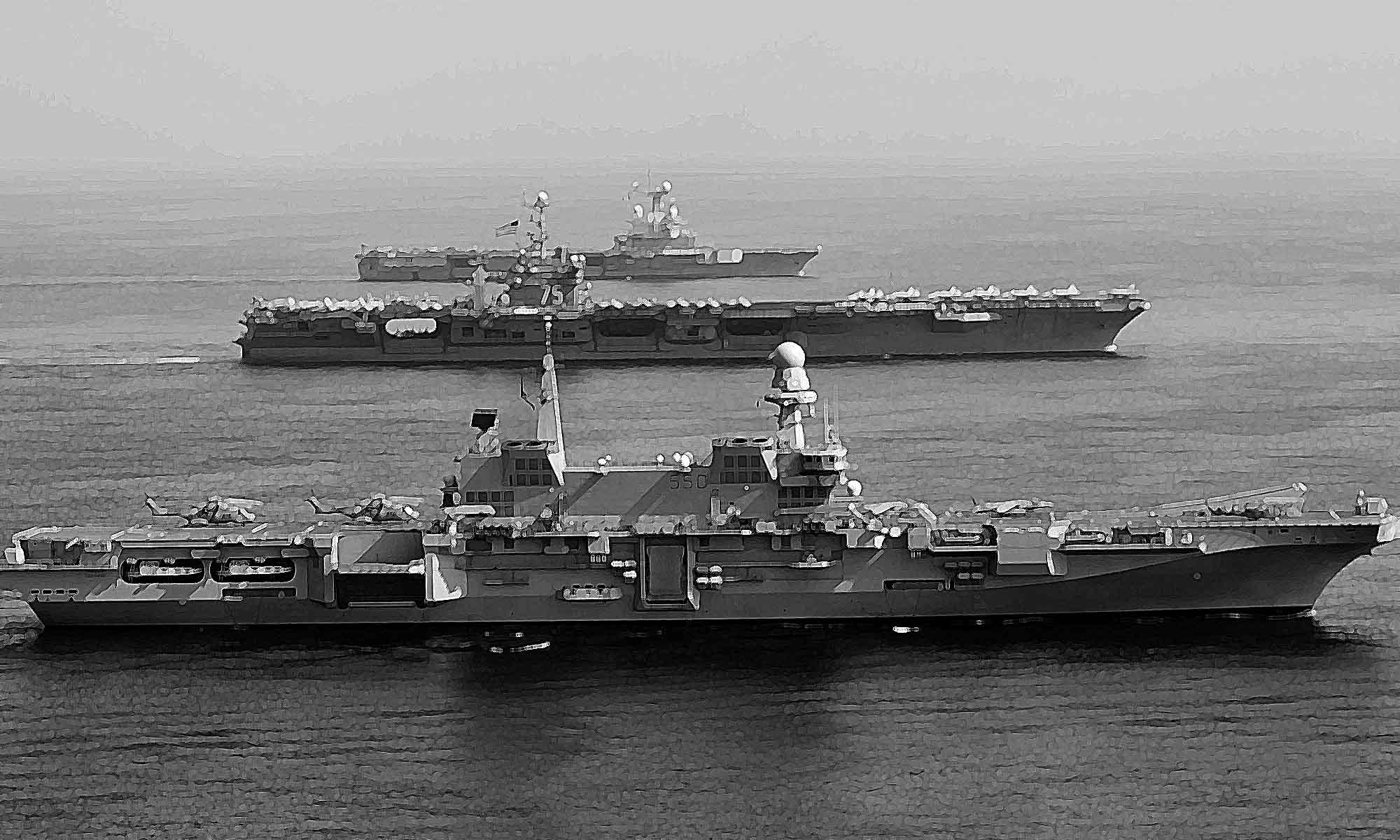
Italian aircraft carrier Cavour in the Gulf of Oman, 2013, with the USS Harry S. Truman (CVN 75, 5th fleet) and FS Charles de Gaulle in the background as TF 473.
A second, larger, ship was planned as of 1995, with possible names are Giuseppe Mazzini or Conti di Cavour (which was the name chosen in the end). This programme was confirmed in 2000 after a long gestation and construction started of a far greater ships displacing 30,000 tonnes (29,900 t) fully loaded, launched 20 july 2004 and completed 27 marzo 2008, the costiest and largest Italian warship ever. In capabilities head and shoulders above the Garibaldi albeit with the same basic requirements, she carried up to 36 VTOL aicraft and helicopters between her deck and hangar, with a permanent park of ten STOVL/V/STOL Harrier II AV-8B and/or F-35B and well as 12 EH-101 AEW/ASW, SH-3D, and AB-212 ASW or NFH-90.
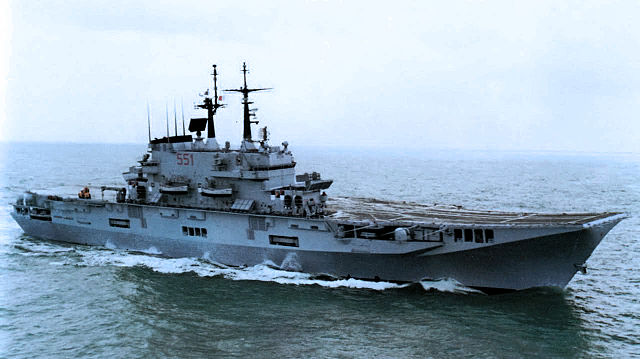
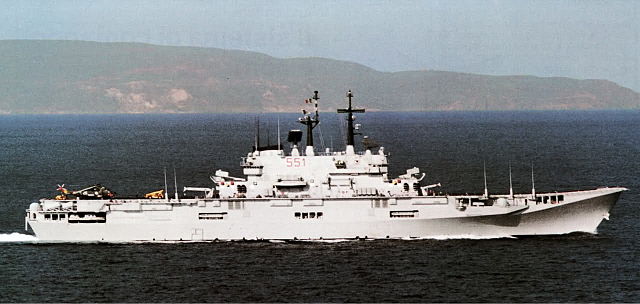
Garibaldi in 1988
Garibaldi (C550) Entered service on 30 September 1985, and was assigned to the 2nd Naval Group, 2nd Division in Taranto. She acted as flagship and headquarters, CiC Naval Squadron. Her first arir group of AB212 helicopters was soon partly replaced by EH101s and she soon took part in intense fleet training and representation activities with several goodwill visits in 1985-91. In the summer of 1991 she sailed to the US for the first time and taked part in the ceremony delivery of her first two two-seat TAV-8B, returning to Italy on 24 September 1991, the two Harrier beiong sent to Grottaglie AB. It seems she took no part at this stage to Operations in the first gulf war.
Crisis in Somalia
She next took part in Indian Ocean operations and the crisis in Somalia. In 1994 she was part of Ibis II mission as command ship for 25th Naval Group centered around her, with the supply ship Stromboli, LPDs San Giorgio and San Marco and covered by the Frigate Scirocco. They covered the Italian contingent deployed there for Operation Restore Hope.
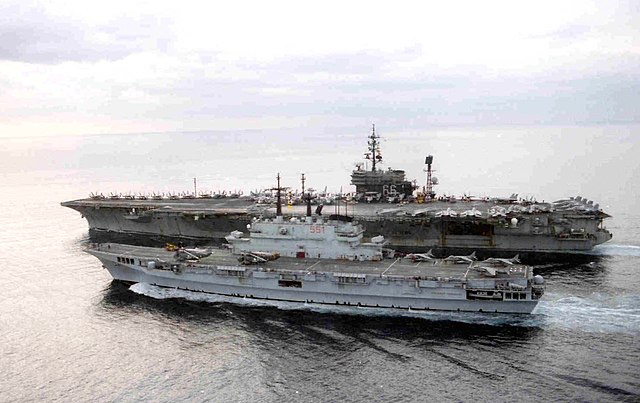
Garibaldi and USS America in 1996
By the spring of 1994 Garibaldi sailed back a second time for the United States and to receive tthree AV-8B+ single-seat, also visiting Baltimore, Boston and New York. Back to Italy, from 11 January and 23 March 1995 she was back in Somali waters for Ibis III, covering the withdrawal of US peace contingent, also acting as command ship for the 26th Naval Group, with Scirocco relieved by Libeccio. Three AV-8B Harrier II , two SH-3D, four AB-212 NLA and four A-129 Mangusta (Army attack helicopter) operated together. The ship also hosted 198 paratroopers and cavary units, 320 men of the San Marco battalion and 30 Comsubin commandos.
From March to June 1997, she took part in Operation Alba Neo off Albania with the air group from Grottaglie AB. F
ollowing the reorganization of the Fleet of 1999, she was assigned to COMFORAL (Offshore Forces Command) in Taranto.
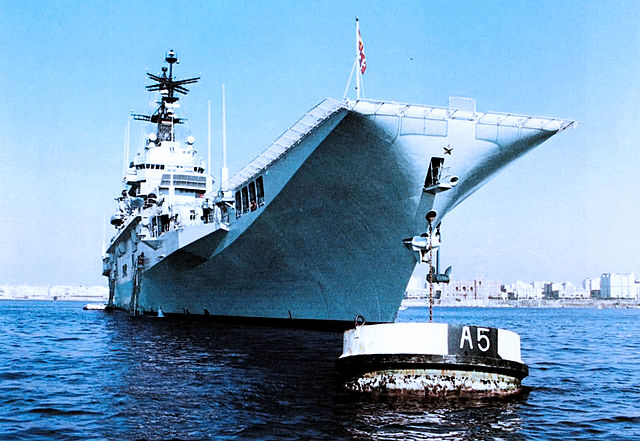
Garibaldi moored in Taranto, early life
Kosovo war:
In 1999, she took part in the Kosovo war, Operation Allied Force. Her AV-8B II+ Harrier carried out 30 sorties, 63 flight hours. They used Mk 82 and GBU-16 bombs, AGM-65 Maverick missiles during the operation. The Italian naval force was also covered by the frigate Zeffiro.
Operation Enduring Freedom
Following the attacks of 11 September 2001 Italy a,swered the call for Operation Enduring Freedom. Garibaldi became the command ship of GRUPNAVIT I (1st Italian naval group) which was escorted by Zeffiro, Aviere and refueler Etna. The group left Taranto on 18 November 2001 for the Indian Oceanvia Suez, operating there from 3 December 2001 to the 1 March 2002, and back to Taranto on 18 March 2002. Garibaldi’s AV-8B Harriers performed 288 flights over 860 hours with a mission of control and interception as well as air support and interdiction over Afghanistan.
2003 modernization
In 2003, Guiseppe Garibaldi started modernization brining her C4I capabilities and Teseo launchers removed, one SCLAR rocket launcher repositioned for an extension of her starboard aft flight deck. She had a completely new Maritime Coordination Center and data system large enough for 100 personal, new SATCOM communication system with data Link 11, 14, 16 and Wide Area Network (WAN), new sonar. After recommissioniong, she took part in NATO Exercize Majestic Eaglein the Atlantic by 2004.
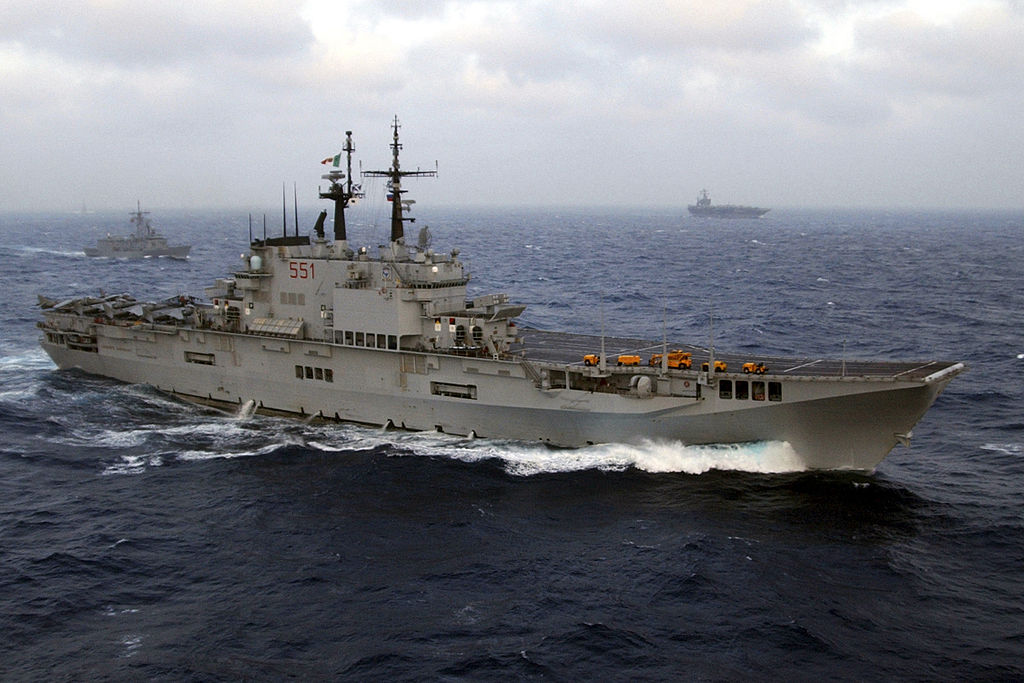
Garibaldi underway in the Atlantic Ocean
2000s Operations
In the summer of 2006, she sortied to take part in the Lebanon crisis but participating first to Operation Mimosa ’06 and Operation Leonte with San Giusto and San Marco, San Giorgio, covered by the frigate Aliseo, destroyer Durand de La Penne. They arrived in the port of Beirut now secured by the San Marco Regiment. A large tonnage of relief aid for the population was landed, including field kitchens, ambulances, electric generators, pneumatic tents, medicine & food delivered by the Italian Ministry of Foreign Affairs, Civil Protection and Italian Red Cross as well as the UN World Food Programme.
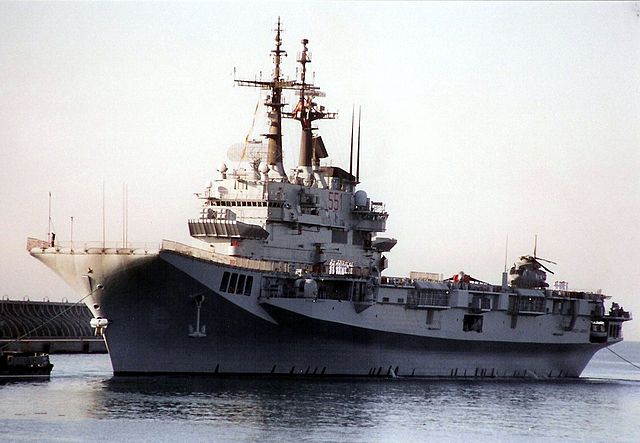
Garibaldi off Malaga, 2004
Mimosa 06 operation had Durand de la Penne sailing out for an exercise in Greece, and later enter the port of Beirut to evacuate compatriots and other Europeans to Cyprus in trips. The San Marco battalion landing from San Giusto nad carrying first relief for the population and proceeding to further evacuations. Operation Leonte in September was under a UN resolution as part of UNIFIL 2. Garibaldi, San Giusto, San Giorgio and San Marco under escort of the corvette Fenice, made a demonstration of Italy’s full amphibious forces and capabilities of Projection force when landed in Tire beach. The “San Marco” Marine Brigade and Lagunari regiment took part in it.
Fior this, Garibaldu deployed her air group for reconnaissance missions on merchant traffic off the Lebanese coast, preventing arms smuggling. Giuseppe Garibaldi was joined the brand new commissioned Conte di Cavour, just completed in 2008 and operational since 2009. She was to replace Vittorio Veneto placed in reserve since 2003. Cavour became the new flagship of the Marina Militare and the fleet deployed in Lebanon.
In September 2008, Garibaldi left for Italy, entiring the drydock for a new long maintenance work scheduled and overdue for years. This 2008 overhaul was in fact the first time the fleet had the Cavour, not yet fully operational as sole aicraft carrier of the Marina Militare available, acting as new flagship.
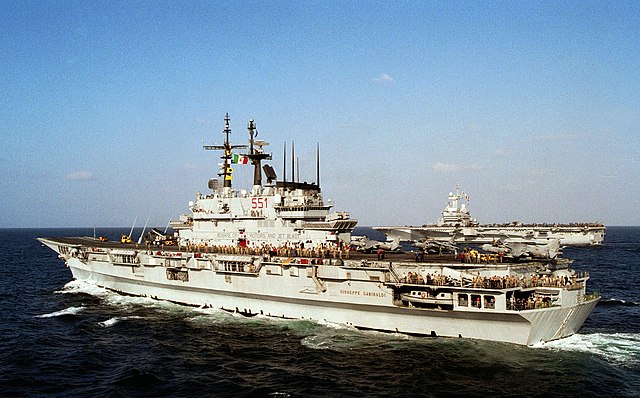
Garibaldi and Charles de Gaulle
Libya: Operation Unified Protector (2011)
Back to service, Garibaldi took part in Operation Unified Protector dealing with the Libyan civil war, and taking active part in the coalition support to the rebels against Ghadaffi. She had by the time eight Harrier available put to good use withing NATO frame, and took the role of command vessel from 25 March to 26 July. Her AV-8B Harrier IIs launched 160 laser-guided missiles/bombs strikes (1221 flight hours total).
2013 Modernization and subsequent Operations
After the navy reorganization of 2013 Garibaldi was assigned to COMGRUPNAVIT together with San Giorgio, San Marco and San Giusto, creating the main Italian assault group whereas Cavour was to act more as a fleet task force center. From 12 September 2014, various commands reaorganized around main bases, made Garibaldi’s group renamed COMGRUPNAV 3, and the ship was tasked to act as command of the naval group and coordinate a national/multinational amphibious force withing NATO procedures.
This 3rd Naval Group consituted the core of the “projection force from the sea”, operating notably the “San Marco” marine brigade Helicopter Assault Department as main air component, meaning Garibaldi’s air group was modified to be more helicopter-centered.
On 13 October 2013 Garibaldi was transferred to the military maritime arsenal of Taranto and was overhauled and modernized again for her service to be extended until 2022.
The work involved almost all of the ship’s systems, mainly concerning the propulsion system, all auxiliary systems, (generators, maintenance systems), plus a full careening, removal of asbestos. The overhaul was to last until 15 March 2015 at an estimated cost of 11 million euros, but was completed ahread of schedule in November 2014 with perfect budget restraint.
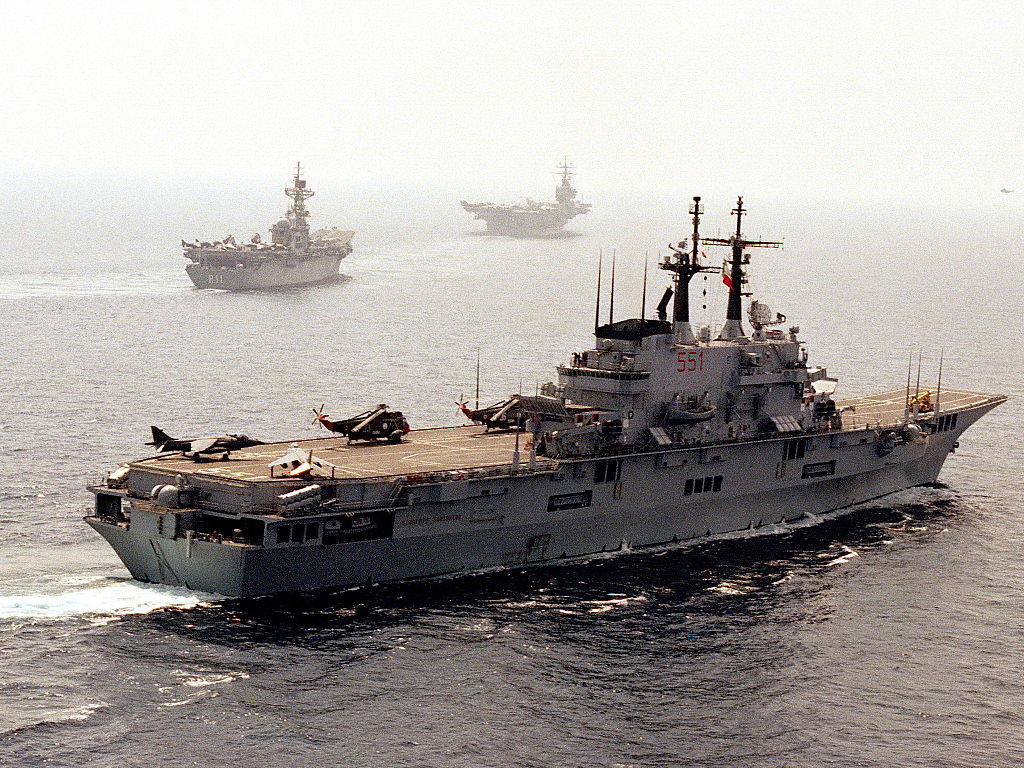
Exercize Dragon Hammer, 3 May 1990
She had new gas turbines, new diesel generators, new electrical network, new flight deck, all support systems for flight operations modernized, new air conditioning system, new lits, cranes, deck vehicles, equipment, hull accessories and finally full overhaul of the armaments of main combat system, electronics. Her oil bilge water treatment system was also made conform to internaitonal ecological regulations, and so was the new painting treatment of the hull, ensuring a longer life and with a coating unsuring fuel consumption lowered by 8-13% and to reduce CO2 emissions. In total her paint was on 5,200 m² of her hull and 4,400 m² of flight deck. But it went beyond as 30 tons of external plating as been replaced, 29,348 m³ treated, 4,880 meters of piping replaced.
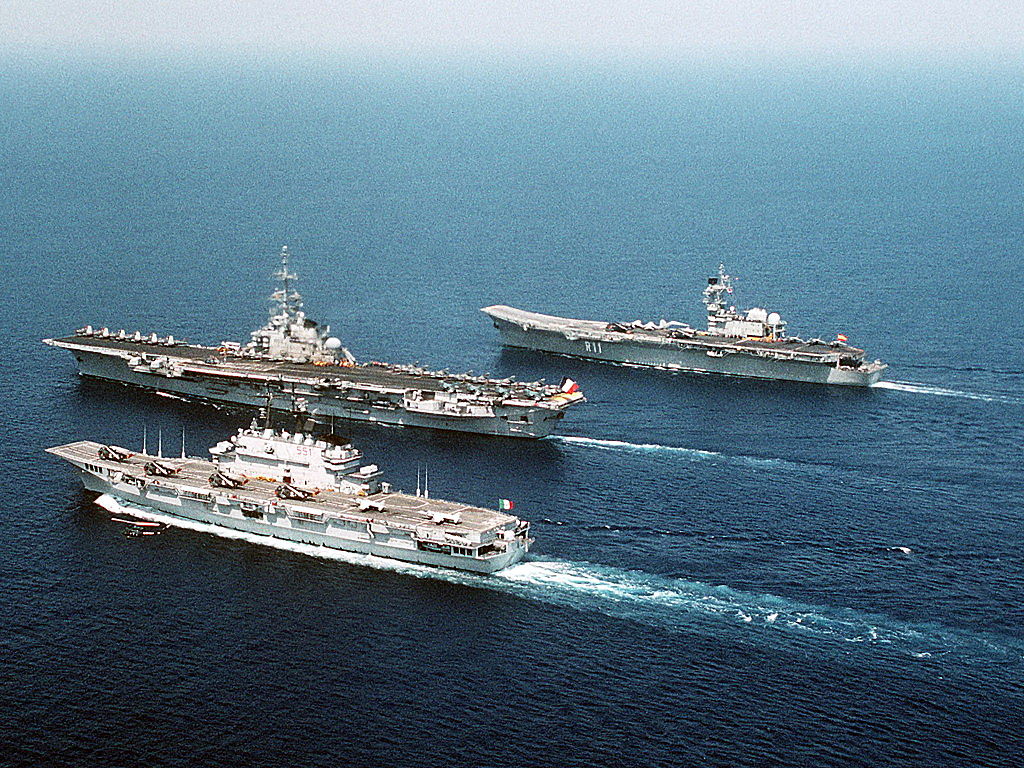
Garibaldi, Foch and Asturias in Dragon Hammer 1992
By June 2016, recommissioned and after refreshing training, she became flagship of Operation Sophia, EUNAVFOR mission, replacing Cavour which herself underwent her first overhaul. On 22 August 2016, off Ventotene island she hosted an UE summit between Italian PM Matteo Renzi, French Pdt. François Hollande and German Chancellor Angela Merkel. This laied the groundwork for larger Bratislava meeting, after the Brexit.
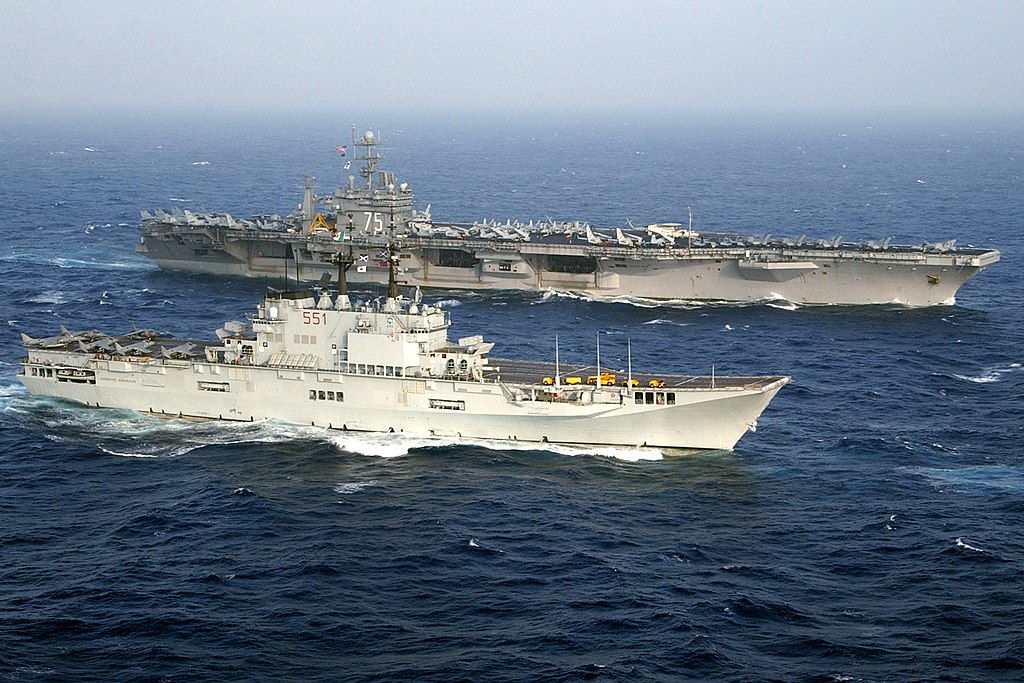
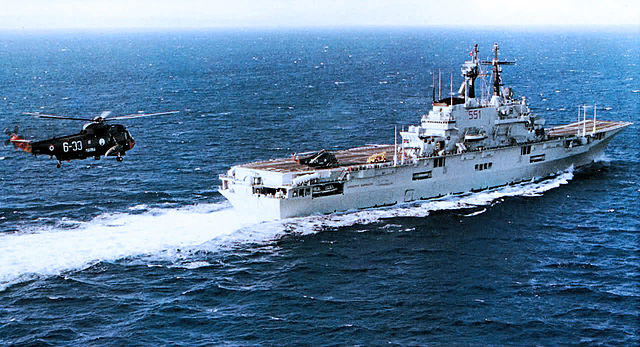
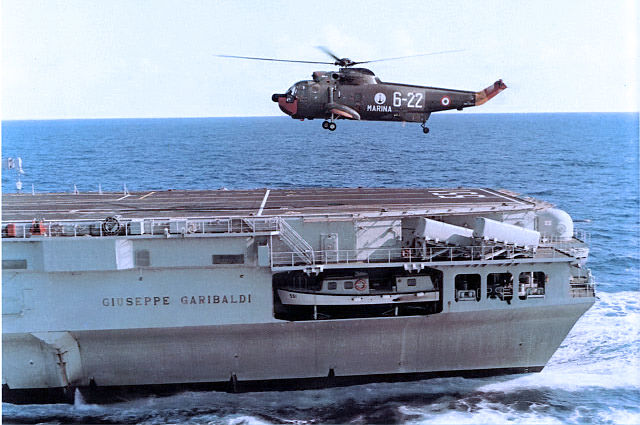
A new career to the horizon ?
In 2021, the General Staff decided not to withdraw Garibaldi despite her incoming retirement date. The expected entry into service of Trieste in 2023 was to mark her official retirement indeed, but it was decided to maintain Garibaldi as platform for the national space strategy, as part of the Joint Force Command for Space Operations, putting her communication systems to good use.
Read More/Src
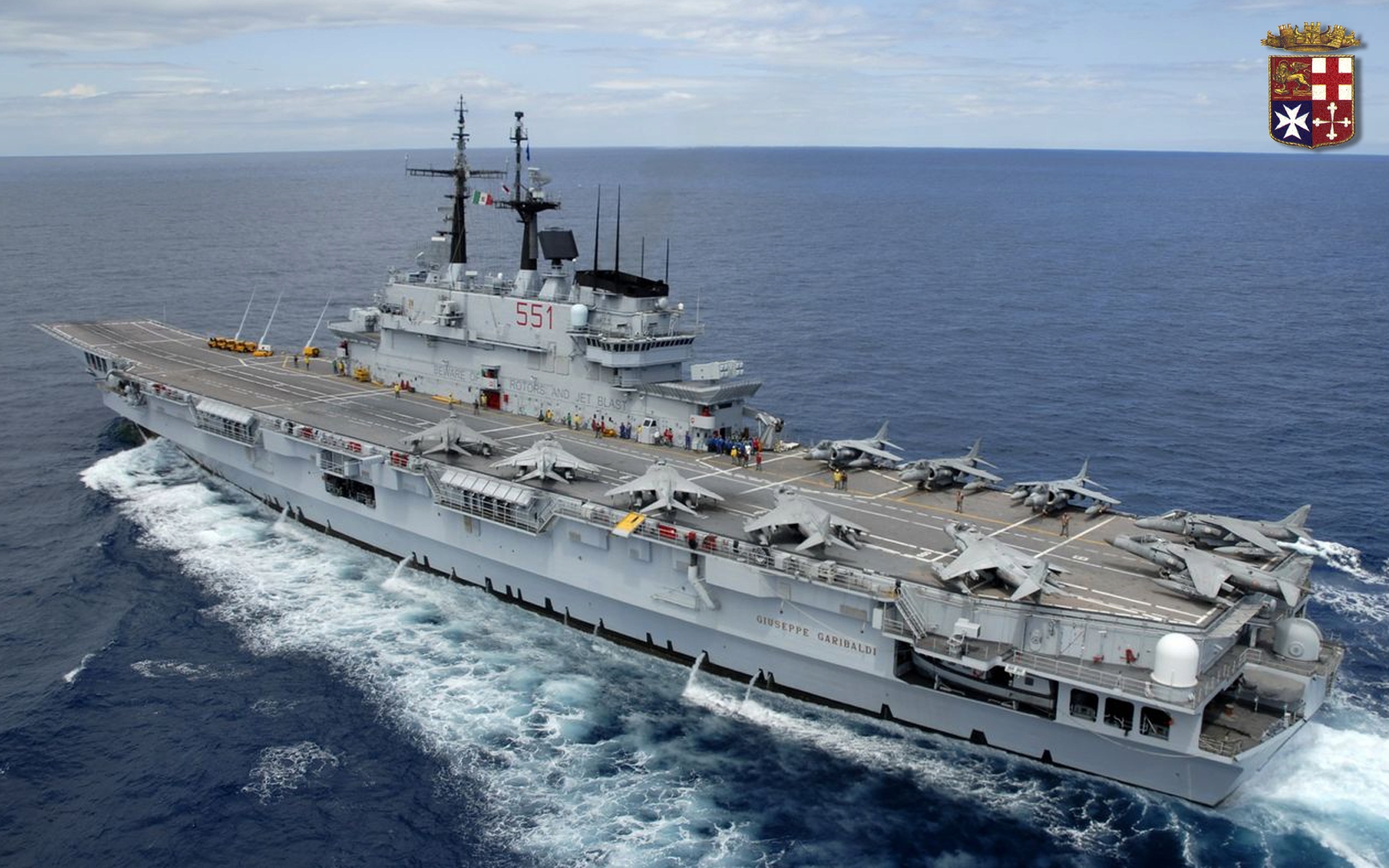
Official photo, src: marina.difesa.it
Books
Robert Gardiner Conway’s All the World’s Fighting Ships 1947-1995, NIP 1996
Links
https://www.globalsecurity.org/military/world/europe/garibaldi.htm
https://www.naval-technology.com/projects/garibaldi/
https://web.archive.org/web/20070905015227/http://www.navytrieste.com/nave_garibaldi_c_551.htm
https://www.militaryfactory.com/ships/detail.php?ship_id=Giuseppe-Garibaldi-551
https://www.marina.difesa.it/Pagine/Search.aspx?k=giuseppe%20garibaldi
https://en.wikipedia.org/wiki/Italian_aircraft_carrier_Giuseppe_Garibaldi
https://it.wikipedia.org/wiki/Giuseppe_Garibaldi_(C_551)
http://navypedia.org/ships/italy/it_cv_giuseppe_garibaldi.htm
Model Kits
Apparently they had been 1/700 scale kits by Tamiya and Fujimi (waterline kits). – More to come.


 Latest Facebook Entry -
Latest Facebook Entry -  X(Tweeter) Naval Encyclopedia's deck archive
X(Tweeter) Naval Encyclopedia's deck archive Instagram (@navalencyc)
Instagram (@navalencyc)





 French Navy
French Navy Royal Navy
Royal Navy Russian Navy
Russian Navy Armada Espanola
Armada Espanola Austrian Navy
Austrian Navy K.u.K. Kriegsmarine
K.u.K. Kriegsmarine Dansk Marine
Dansk Marine Nautiko Hellenon
Nautiko Hellenon Koninklije Marine 1870
Koninklije Marine 1870 Marinha do Brasil
Marinha do Brasil Osmanlı Donanması
Osmanlı Donanması Marina Do Peru
Marina Do Peru Marinha do Portugal
Marinha do Portugal Regia Marina 1870
Regia Marina 1870 Nihhon Kaigun 1870
Nihhon Kaigun 1870 Preußische Marine 1870
Preußische Marine 1870 Russkiy Flot 1870
Russkiy Flot 1870 Svenska marinen
Svenska marinen Søværnet
Søværnet Union Navy
Union Navy Confederate Navy
Confederate Navy Armada de Argentina
Armada de Argentina Imperial Chinese Navy
Imperial Chinese Navy Marinha do Portugal
Marinha do Portugal Mexico
Mexico Kaiserliche Marine
Kaiserliche Marine 1898 US Navy
1898 US Navy Sovietskiy Flot
Sovietskiy Flot Royal Canadian Navy
Royal Canadian Navy Royal Australian Navy
Royal Australian Navy RNZN Fleet
RNZN Fleet Chinese Navy 1937
Chinese Navy 1937 Kriegsmarine
Kriegsmarine Chilean Navy
Chilean Navy Danish Navy
Danish Navy Finnish Navy
Finnish Navy Hellenic Navy
Hellenic Navy Polish Navy
Polish Navy Romanian Navy
Romanian Navy Turkish Navy
Turkish Navy Royal Yugoslav Navy
Royal Yugoslav Navy Royal Thai Navy
Royal Thai Navy Minor Navies
Minor Navies Albania
Albania Austria
Austria Belgium
Belgium Columbia
Columbia Costa Rica
Costa Rica Cuba
Cuba Czechoslovakia
Czechoslovakia Dominican Republic
Dominican Republic Haiti
Haiti Hungary
Hungary Honduras
Honduras Estonia
Estonia Iceland
Iceland Eire
Eire Equador
Equador Iran
Iran Iraq
Iraq Latvia
Latvia Liberia
Liberia Lithuania
Lithuania Mandchukuo
Mandchukuo Morocco
Morocco Nicaragua
Nicaragua Persia
Persia San Salvador
San Salvador Sarawak
Sarawak Uruguay
Uruguay Venezuela
Venezuela Zanzibar
Zanzibar Warsaw Pact Navies
Warsaw Pact Navies Bulgaria
Bulgaria Hungary
Hungary

 Bundesmarine
Bundesmarine Dutch Navy
Dutch Navy Hellenic Navy
Hellenic Navy Marina Militare
Marina Militare Yugoslav Navy
Yugoslav Navy Chinese Navy
Chinese Navy Indian Navy
Indian Navy Indonesian Navy
Indonesian Navy JMSDF
JMSDF North Korean Navy
North Korean Navy Pakistani Navy
Pakistani Navy Philippines Navy
Philippines Navy ROKN
ROKN Rep. of Singapore Navy
Rep. of Singapore Navy Taiwanese Navy
Taiwanese Navy IDF Navy
IDF Navy Saudi Navy
Saudi Navy Royal New Zealand Navy
Royal New Zealand Navy Egyptian Navy
Egyptian Navy South African Navy
South African Navy






























 Ukrainian Navy
Ukrainian Navy dbodesign
dbodesign